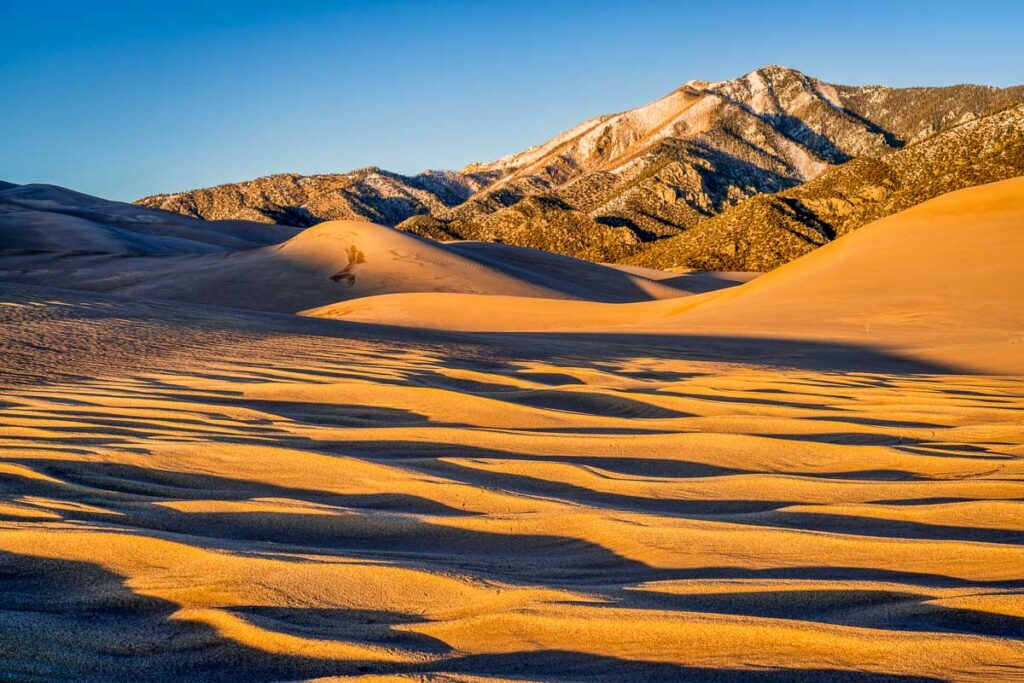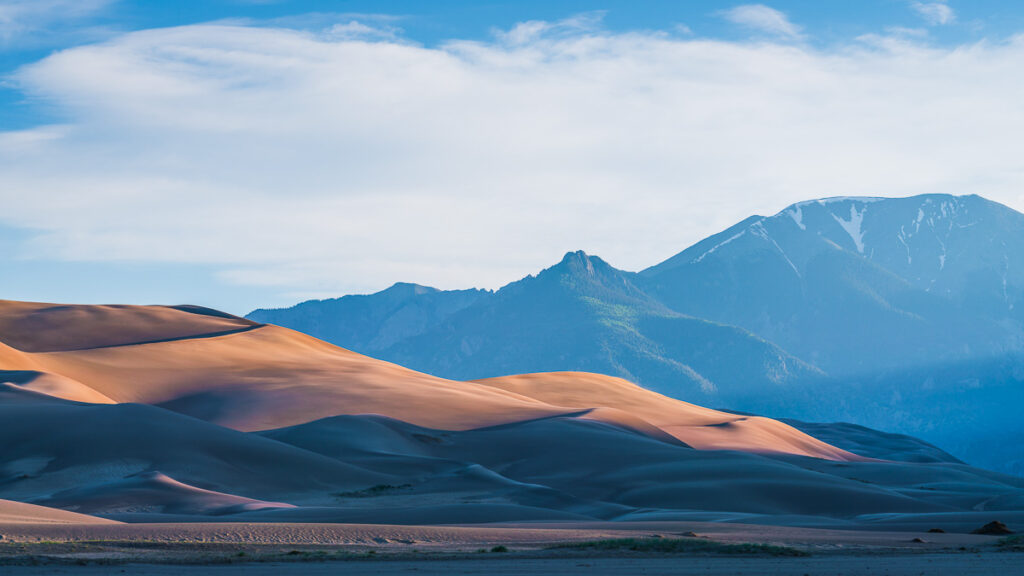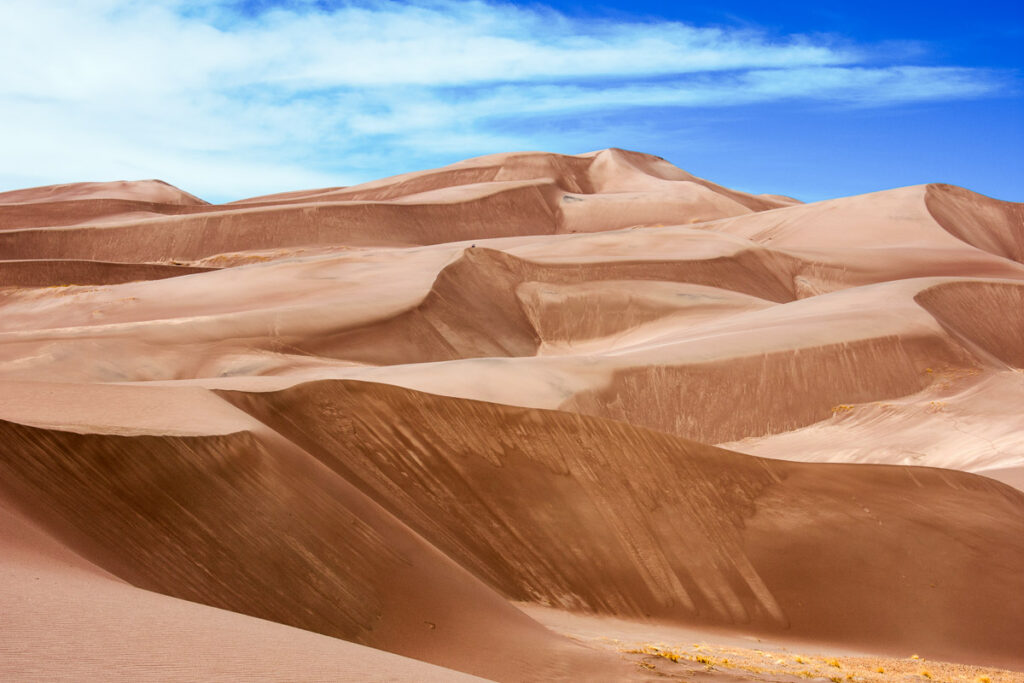Why Now is the Best Time to Visit Great Sand Dunes National Park

When’s the best time to visit Great Sand Dunes National Park, a place that boasts the tallest sand dunes in North America?
During the van life years where I was hopping from one national park to over 25+ others, I found myself at the doorstep of this natural marvel a bit too early in the season, in late March.
The weather at Great Sand Dunes is highly variable due to its high elevation of over 8,000 feet, ranging from scorching hot summers to chilly, sometimes snowy winters. So, here’s a summary of the visitor seasons:
- Best Season: Late May to Early June or September
- Peak Season: June to August
- Off-Peak Season: December to March
Ready for the specifics of each season, including must-see events and typical weather conditions? Whether you’re planning a quick day trip to Great Sand Dunes or a more extended stay, go sandboarding and sledding, or hike through the dunes, now is the perfect time to visit Great Sand Dunes.

Best Time to Visit Great Sand Dunes
Best Time of Year to Visit
In general, late May through early June is the best time to pay Great Sand Dunes National Park a visit. You’ll not only dodge the harsh desert sun but also catch the park’s unique surge flow phenomenon, which looks like mini waves in the sand.
A little bit later in the season, in June and July, you’ll catch Colorado’s wildflowers sprouting all over the dunes.
Best Time for Good Weather
For those chasing the best weather, aim for late spring or late September to early October. Perfect daytime temps hover around the comfortable 60s to low 70s °F, with much cooler nights that make for ideal camping conditions. Plus, you’re less likely to get caught in a late summer thunderstorm.
Best Time to Avoid Crowds
To have more of the dunes to yourself, travel during the off-peak season, from November to March. Sure, it’s colder, but the number of visitors drops dramatically, from 100,000+ visitors monthly in the peak months to less than 7,000.
Cheapest Time to Visit
Late winter to early spring is the cheapest visit to Great Sand Dunes National Park. During this time, accommodation rates in nearby towns plummet, however it’s too cold to camp which would otherwise be the cheapest option.
Worst Time to Visit Great Sand Dunes
The worst time to visit Great Sand Dunes National Park has to be mid-summer, specifically July and August. You’ll be wrestling with scorching temperatures that can soar above 90°F, making any daytime adventure feel like a trek through an oven. Not to mention, this is when the park is at its busiest, meaning you’ll be fighting for that perfect dune photo op.

Seasons of Great Sand Dunes
Spring (April to June)
March is still very chilly in Great Sand Dunes, where you might still spot snow dusting those epic dunes. But as we roll into April and May, the park undergoes a drastic change.
Temperatures start to creep up, averaging between 45°F to 60°F. This gradual warming ushers in the much-anticipated surge flow around late May, transforming Medano Creek into a mini beach.
You’re likely to spot a variety of birds and critters waking up from hibernation. On the plant front, wildflowers begin to dot the landscape with color.
Spring weather here can be a bit of a wildcard. One day, it’s sunny and warm, and the next, you might find yourself caught in a surprise spring shower or even a late snow flurry.
Crowding is on the rise, especially as May approaches. Early spring (March to early April) is still a quieter experience, but by late May, you’re sharing the park with more visitors drawn in by the warmer weather and the surge flow spectacle.
Key Events:
- Monte Vista Crane Festival (March): This event is the unofficial kickoff to the outdoor season, with thousands of cranes, ducks, and geese migrating.
- We Love Our National Park Celebration (April): Held in nearby Alamosa, this event celebrates everything great about national parks with food, music, and educational activities.

Summer (July to August)
By the time June hits, the park fully embraces the heat, with daily temperatures often jumping to the 80°F-90°F range. If you think sand at the beach gets hot, the dunes can get even hotter, easily hitting 150°F underfoot.
Summer storms, especially in July, are not uncommon. They roll in quickly, lighting up the sky with dramatic thunder and lightning shows. These storms are short-lived but intense, making afternoons unpredictable.
Of course, with summer comes peak visitor season. Expect more company on the trails and around popular spots.
Medano Creek’s surge flows have tapered off by early summer, but there’s still enough water early in the season for splashing around, and the higher stream flow from spring melt makes for some fun, albeit cold, dips.
Key Events:
- ACA Great Sand Dunes Adventure Festival (June): An event featuring sandboarding competitions, 4×4 dune riding, and other high-energy activities.
- Colorado Light The Night Sky Lantern Festival (June): See the dunes and sky light up with hundreds of lanterns at this unique festival.
- SummerFest on the Rio (May to June):

Fall (September to October)
Fall is a bit of an in-between season at Great Sand Dunes. The park gradually transitions from hot summer days to cooler nights, eventually dipping below freezing by late October. Daytime temperatures can still be pleasant, though, averaging between 50°F to 75°F during the day, with cooler nights that make camping a delight.
The changing foliage against the backdrop of massive sand dunes creates a palette of colors against the stark contrast to the usual monochromatic sandy scene. The lower temperatures also mean longer, more comfortable hikes without the midday heat beating down on you.
The cooler weather brings out a variety of animals preparing for the winter, from migrating birds to local fauna like deer and elk, often spotted in the early mornings or late afternoons.
Fall also means fewer crowds, giving you a sense of having the vast dunes almost to yourself.
Winter (November to March)
Winter is long here, with the cold taking over for almost half the year. Due to its elevation, snow covers the dunes, and temperatures plummet well below freezing at night and hover between 20°F to 40°F during the day. Light snowfall can happen anytime during this period.
The park sees its lowest visitor numbers during winter, with only a couple thousand visiting per month. But for those who do come, you can even swap sandboarding with some mini-snowboarding sessions.
Wildlife will be much more scarce, but for those with a good eye, you can see tracks of deer, rabbits, and other animals crisscross the untouched snow.
Key Events:
- Annual Christmas Bird Count (December): Join in on the longest-running citizen science project in history and help collect valuable data on bird populations.
- OSO Cold Winter Fest (February): A local festival celebrating all things winter, from snow sculpture contests to ice fishing.

Great Sand Dunes Weather By Month
Below is a detailed month-by-month analysis of the typical high and low temperatures, snowfall, and rainfall levels at Great Sand Dunes:
| Month | Avg High Temp | Avg Low Temp | Precipitation (Days) | Snowfall (Inches) |
| Jan | 35°F | 4°F | 0.4d | 3.7″ |
| Feb | 41°F | 11°F | 0.9d | 3.6″ |
| Mar | 51°F | 20°F | 2.0d | 3.3″ |
| Apr | 59°F | 27°F | 3.3d | 2.3″ |
| May | 69°F | 36°F | 4.1d | 0.4″ |
| Jun | 78°F | 43°F | 3.4d | 0.0″ |
| Jul | 81°F | 49°F | 7.4d | 0.0″ |
| Aug | 78°F | 47°F | 8.7d | 0.0″ |
| Sep | 72°F | 39°F | 5.7d | 0.0″ |
| Oct | 61°F | 27°F | 3.4d | 1.1″ |
| Nov | 47°F | 16°F | 1.4d | 3.3″ |
| Dec | 36°F | 6°F | 0.5d | 4.3″ |
Before you Close That Tab…Where to Next in Colorado?
I’ve vanlifed south to the north all of Colorado in the dead of winter to early spring. Let me tell you, it was cold, but turn on that buddy heater, and let’s hit the slopes. If you’re looking for more information on Colorado, check out these other destination itineraries.
- Perfect One Day In Mesa Verde National Park Itinerary
- Perfect One Day In Black Canyon Of The Gunnison Itinerary
- Unbeatable One Day In Rocky Mountain National Park Itinerary
- One Day In Boulder Itinerary: What Not To Miss On A Day Trip
- Perfect One Day In Denver Itinerary For First-Timers
- Perfect One Day In Great Sand Dunes National Park Itinerary
| MY FAVORITE TRAVEL RESOURCES |
✈️ Find amazing guided tours and experiences with Viator to maximize your time! 🏘️ Plan ahead and secure your accommodation with Booking.com in advance. 🧾 Rent a car with Discovercars in advance and get the best prices for your day trip adventures. |
